9mm vs 45 ACP: The Greatest Pistol Caliber Debate
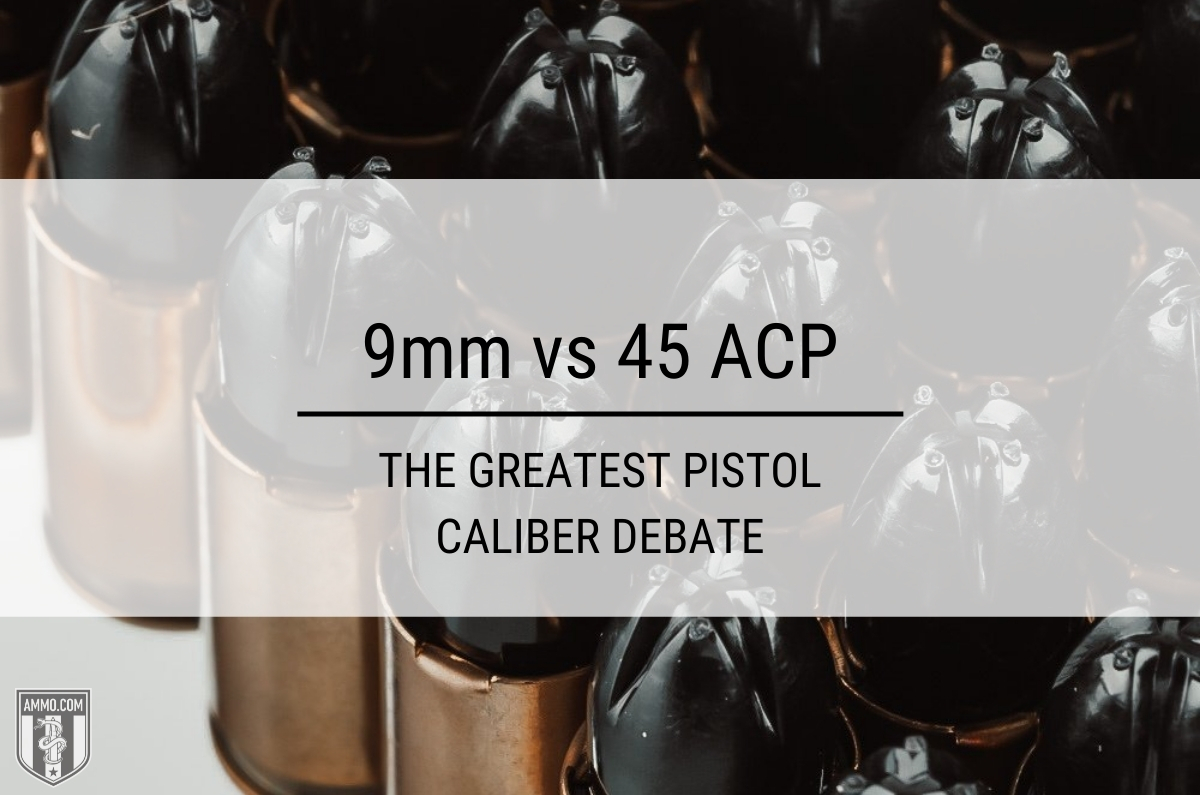 There are many great debates that grace the display cases of gun stores and internet forums about which personal defense ammo or firearm is superior…1911 vs Glock, AR-15 vs AK-47, 30-06 Springfield vs 308 Winchester, and 9mm vs 40 Smith and Wesson to name a few.
There are many great debates that grace the display cases of gun stores and internet forums about which personal defense ammo or firearm is superior…1911 vs Glock, AR-15 vs AK-47, 30-06 Springfield vs 308 Winchester, and 9mm vs 40 Smith and Wesson to name a few.
And although proponents of certain firearms/cartridges are often very stalwart in their positions, there are none that are so unrelenting, tenacious, and resolute in their position than those in the 9mm vs 45 ACP caliber debate.
Many shooters will make the blanket statement that the debate over 9mm Luger and 45 ACP comes down to magazine capacity vs stopping power.
However, this is a very apples to oranges approach when it comes to comparing these two personal defense handgun calibers.
Let's take an objective look at the 9mm vs 45 ACP debate and compare the history, ballistics, advantages, and disadvantages of the two most popular self-defense handgun cartridges in the world.
Load up your favorite Glock 17 magazines with your 9mm ammo of choice and get your 1911 oiled up because you are about to read the most objective 9mm vs 45 ACP caliber debate on the Internet.
What is 45 ACP? America’s Two-Time World War Winning Handgun Cartridge
The 45 ACP (Automatic Colt Pistol) was developed by the renowned American firearms inventor, John Moses Browning, in 1904. The 45 ACP was an innovation, as many are, birthed from necessity.
During the Philippine-American War, the US Cavalry became displeased with the lack of stopping power provided by their .38 Long Colt sidearms. The primary conflict that led to this discovery was the Moro Rebellion where cavalrymen were reporting Moro warriors soaking up shot after shot from their .38 Long Colt revolvers without stopping.
The US Military concluded that bigger bullets with more stopping power were required, and that the ideal caliber for this duty was .45 due, in part, to the success of the 45 Long Colt. The previous standard-issue sidearm for the Cavalry was the iconic Colt Single Action Army revolver.
Prior to this development, John Moses Browning had been working in tandem with Colt to develop a new 41 caliber for consideration. However, when this new order came from the US Military, Colt and Browning increased the caliber to .45.
Initially, the new 45 ACP cartridge was designed to fire a 200-grain bullet at 900 fps. However, after some modifications by the Frankford Arsenal, Union Metallic Cartridge, and Winchester, the finalized version was adorned with a 230-grain full metal jacket (FMJ) fired at 850 fps.
The final version of the 45 ACP mimicked the ballistic performance of the 45 Schofield and the 45 Long Colt but was significantly shorter.
In 1906, Colt (using Browning’s design) and 5 other firearms manufacturers submitted handguns for consideration. Only Colt and Savage Arms made the final cut in 1910.
The resulting testing run by the US Military showed the Colt submission experiencing zero failures while the Savage sidearm had 37 stoppages. The Colt handgun was selected as the Model 1911.

The Colt 1911 and the 45 ACP served in all branches of the US Military for the next 70+ years as the standard-issue sidearm and ammo. It carried us through World War I and II, the Korean War, and Vietnam. It was not until the 1980s that the military decided to update their service pistol and opted to move towards the Beretta M9 and the 9mm Luger cartridge.
The 45 ACP and Model 1911 were the longest-serving cartridge and sidearm in US history and were still used in Special Forces units well after the adoption of the Beretta M9.
The 45 ACP is well renowned for its stopping power, accuracy, and reliability.
In general, the 45 ACP is a low-pressure round with SAAMI specs citing a maximum pressure of 19,900 psi (considerably less than 35,000 psi for 9mm). It is naturally subsonic, which makes it ideal for use with a suppressor/silencer or submachineguns.
Your standard, off-the-shelf 230-grain full metal jacket (FMJ) Winchester ammo will have a muzzle velocity of 835 fps and muzzle energy of 356 foot-pounds of force.
The 45 ACP is truly America’s Cartridge and it has a huge following both in the military, law enforcement, and civilian shooting circles.
What is 9mm? The German Military Powerhouse
The 9x19mm Parabellum was designed by the Austrian gunsmith Georg Luger in 1901. Luger derived the 9mm Parabellum from his previous design, the 7.65x21mm Parabellum.
In 1903 he presented the 9mm Parabellum to the US military for consideration at the Springfield Arsenal and was in competition with Browning and the 45 ACP. The 9mm was not adopted by the US military until much later and was instead picked up by the German Imperial Navy and Army in 1904 and 1908, respectively.
The 9x19mm Parabellum is also referred to as the 9x19mm NATO, 9mm Luger, or simply the 9mm. SAAMI specs list the maximum pressure for 9mm at 35,000 psi and standard 115 grain FMJ ammo will have an average muzzle velocity of 1180 fps and a muzzle energy of 355 foot-pounds.
After World War I and through World War II, the 9mm Luger cartridge and its accompanying Luger P-08 handgun became one of the most popular handgun cartridges in Europe for both military and law enforcement. However, the United States was late to the party as it clung to the idiom, “Bigger Bullets are Better” and our beloved 45 ACP until the 1980’s with the adoption of the Beretta M9 Service Pistol by the US Army.
The popularity of the 9mm Luger really exploded in the United States during the 80s and 90s with the introduction of extremely reliable semi-auto pistols, such as the Glock 17, the Sig Sauer P226, and more recently the Springfield XD and the Smith and Wesson M&P.
The 9mm has become synonymous with law enforcement and home defense for its high magazine capacity, stopping power using jacketed hollow point ammo (JHP), and low overall cost per round.
9mm pistols are extremely easy to come by and are relatively inexpensive as all major firearms manufacturers carry some offering for the 9mm cartridge: Glock, Smith and Wesson, Sig Sauer, Kimber, Springfield, Remington, Ruger, and Taurus, just to name a few!
It has truly become the everyday carry (EDC) handgun of choice if you don’t want to carry something more sizable and snappier like a 357 Magnum. With advancements in hollow point technology, the 9mm has solidified itself as the self-defense ammo of choice for the military, law enforcement, and the civilian concealed carry permit holder.
9mm vs 45 ACP: The Difference Between 9mm and .45
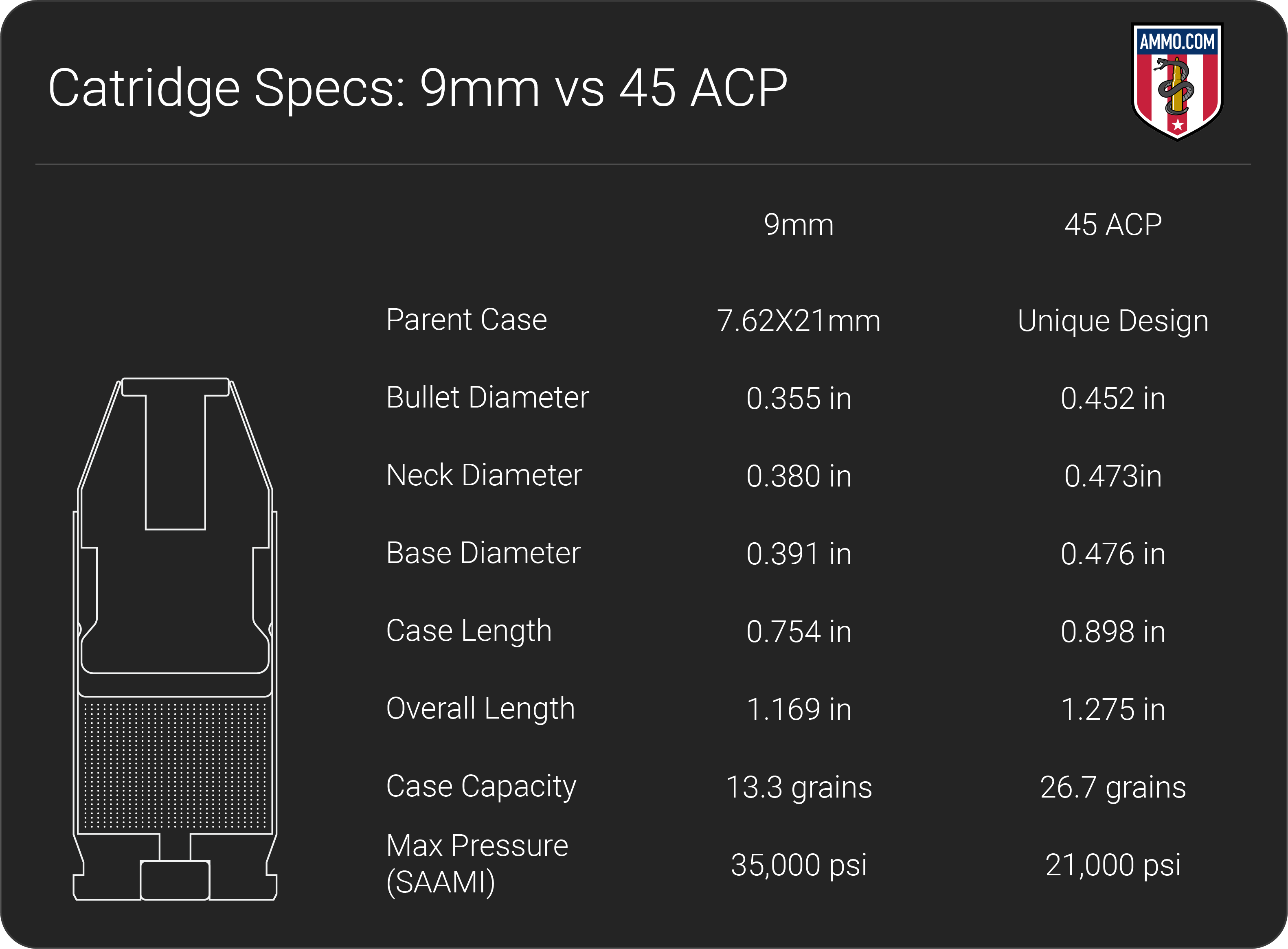
The 9x19mm NATO and the 45 ACP are two of the most popular semi-auto handgun calibers worldwide. Both have a devout following of die-hard shooters for good reason! They both excel as a self-defense round and, if your shot placement is good, will defend your life should that fateful moment arise.
But can one be labeled as superior to the other? I doubt it.
Your choice between loading up your EDC handgun with a 9mm Hornady Critical Defense round or a 45 ACP Winchester Ranger-T hollow point will depend a lot on YOU and your personal preferences.
In the following comparison, we will look that the 45 ACP and the 9mm Luger with an unbiased eye so that You can make an informed decision on your next semi-auto pistol purchase.
45 ACP vs 9mm: Stopping Power
One of the top three discussion points in the 45 vs 9mm debate is stopping power.
Proponents of the 45 ACP are going to harp on the mystical concept of “Stopping Power” stating that the 9mm is underpowered and a heavier bullet is needed to stop a threat. Many an Internet forum is riddled with unsubstantiated reports of a bad guy soaking up shots from a police officer wielding a 9mm gun without even batting an eye.
The 45 ACP is undoubtedly the superior cartridge when it comes to kinetic energy as it fires a heavier bullet, but how is “stopping power” defined? Although there is not a column in the ballistics chart for stopping power, the FBI testing protocol is widely accepted as the best real-world simulation for testing ammunition.
The FBI Ammunition Testing Protocol was developed after the 1986 Miami Shootout where two FBI agents lost their lives. It was determined that the 9mm round the officers used was ineffective and spurned the FBI’s decision to move away from the 9mm to the 40 Smith and Wesson (40 S&W) cartridge.
For the purpose of this comparison, we will only discuss hollow point ammo as it is what you should be loading into all of your concealed carry handguns. Hollow point bullets will expand when they encounter soft tissue, decreasing the amount of penetration and increasing the amount of damage that the bullet will cause.
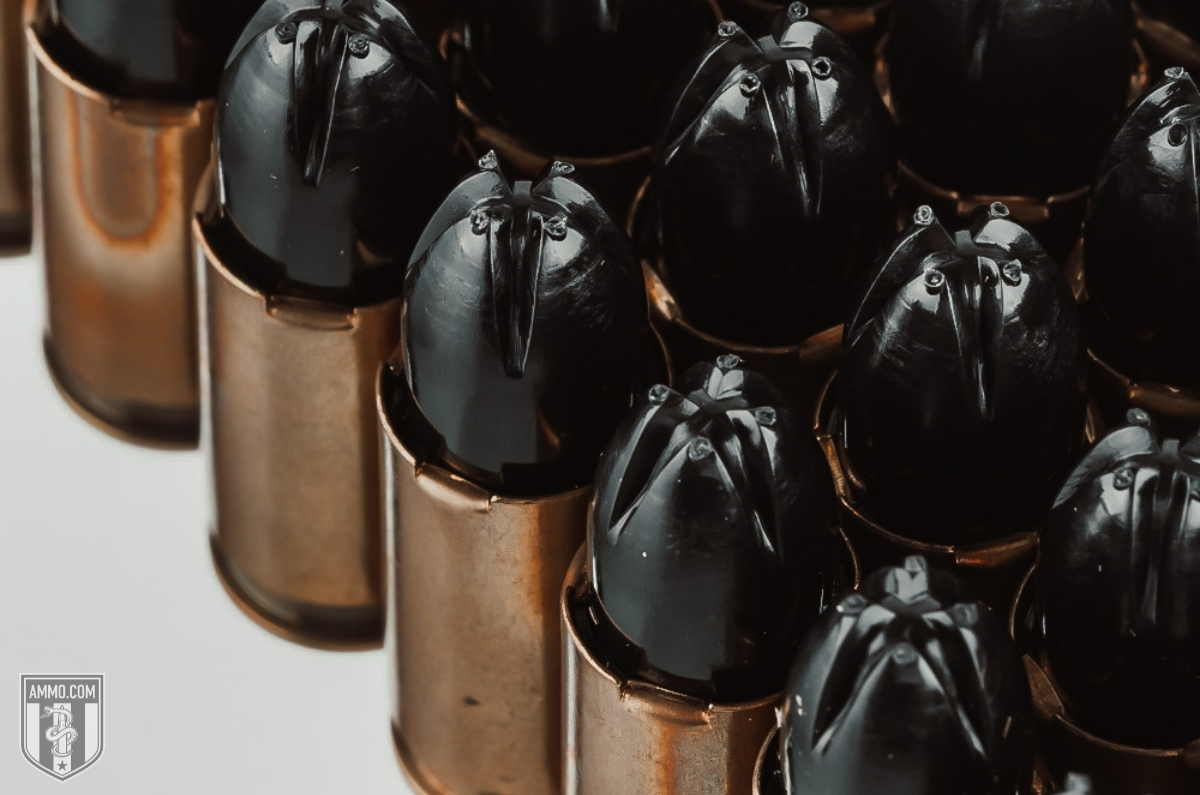
FMJ ammo should not be used in your EDC pistol as a full metal jacket will not expand and likely over penetrate through the bad guy into an innocent bystander and/or through internal walls.
For modern 9mm JHP ammo, penetration is around 13-15 inches on average. In contrast, 45 ACP hollow point ammo will typically penetrate inside the range of 12-14 inches. For the most part, both will penetrate the same amount.
However, one major difference between the .45 and 9mm bullet is the amount of expansion that occurs when the hollow point opens up. In general, a 9mm round will expand from 0.355” to around 0.6”, virtually doubling in diameter. In comparison, the 45 ACP will do the same, expanding from 0.452” to around 1”, again doubling.
This means that the 45 ACP will create a larger permanent wound channel inside the bad guy. In turn, causing additional blood hemorrhaging and increase the probability that an internal organ will be lacerated.
Overall, the 45 ACP is a bigger, fatter, slower round than the 9mm resulting in shallower penetration for the venerable .45. However, that’s not a bad thing as overpenetration is a real (legal) issue should you hit something you didn’t intend.
As the 45 ACP leaves a larger permanent wound cavity, imparts more momentum into the target, and has a tendency to not over-penetrate, it’s a fair statement that the 45 ACP has more stopping power than a 9mm. Advancements in hollow point technology have brought the 9mm bullet on par with the 45 ACP but the .45 is still just a bigger, heavier bullet and that cannot be contested.
But this is only half of the story! Let’s continue onto magazine capacity.
45 vs 9mm: Magazine Capacity
Proponents of 9mm pistols love to cite the fact that 9mm magazines have a higher capacity than their 45 ACP counterparts, and they are 100% correct.
Early magazine designs for the 45 ACP utilized what is referred to as a “single stack” design, meaning that one round sat on top and the other in a vertical orientation.
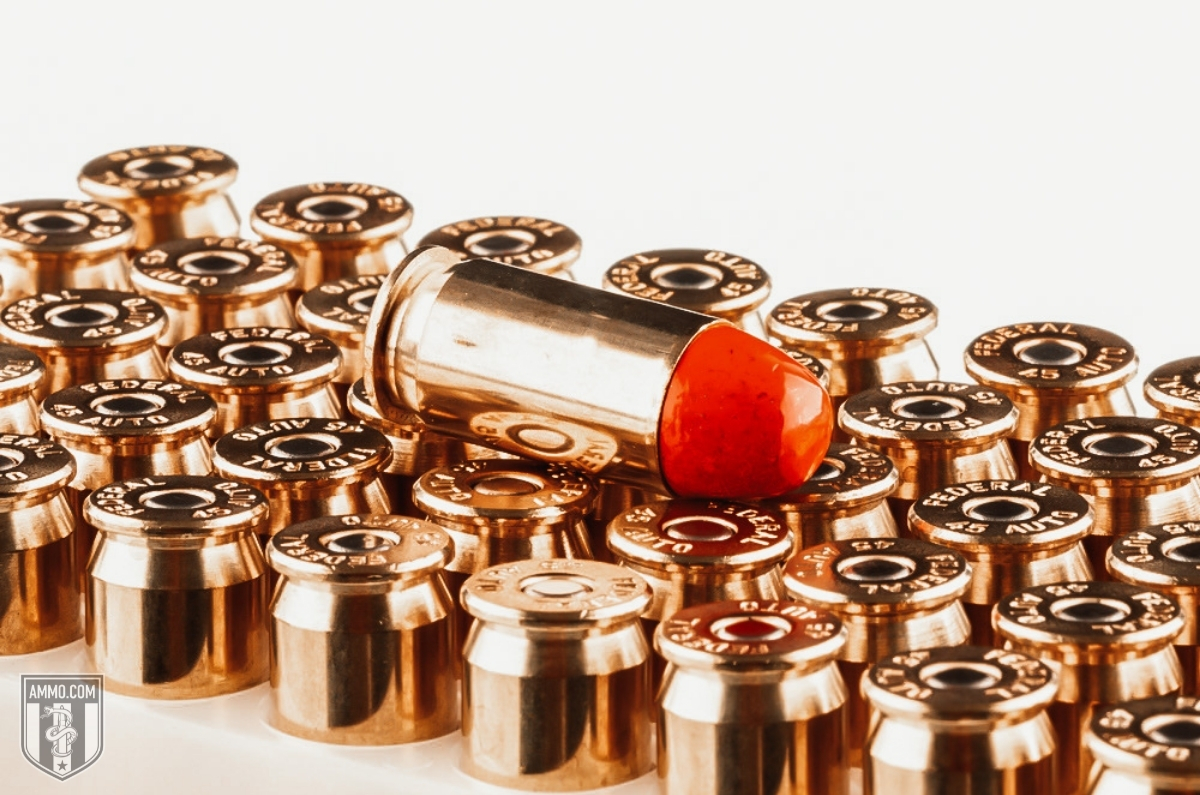
However, as the 9mm is smaller, initial designs for 9mm magazines use a “double stack” design, meaning that the rounds are staggered in a diagonal pattern as they move up the magazine wall.
The double-stack design allows for more magazine capacity at the cost of the magazine being wider.
Right about now, the 45 ACP fanboys are clamoring in the comments section, screaming at the top of their lungs, “Hey! We have double stack mags, too!” And it’s true they do, however, they will never come close to the magazine capacity of a 9mm.
Your standard Glock 17 magazine holds 17 rounds of 9mm ammo, while the Glock 21 magazine can only hold 13 rounds of 45 ACP.
Being able to bring more ammo to bear in a self-defense situation allows you to stay in the fight longer before you have to result to hand-to-hand combat. This gives the 9mm a distinct advantage as any shooter will always pick more bullets over less.
The military seems to agree with this concept based on their decision to switch from the 308 Winchester to the 5.56 NATO in Vietnam as well!
However, please be aware of your state laws as some states like New York and California restrict high-capacity magazines. In this case, those higher capacity magazines might not be a true advantage so always be aware of what you are allowed to carry.
However, all things being 2A Equal, the 9mm allows a responsible concealed carry permit holder or police officer to carry more ammo into a gunfight and that is a distinct advantage over the 45 ACP.
45 ACP vs 9mm: Recoil
The 9mm Luger has approximately half the felt recoil of the 45 ACP, and this is the third major point of debate in the 9mm vs 45 ACP battle.
The 9mm cartridge fires a lighter bullet at a higher velocity, whereas the 45 ACP fires a heavier bullet at slower velocities.
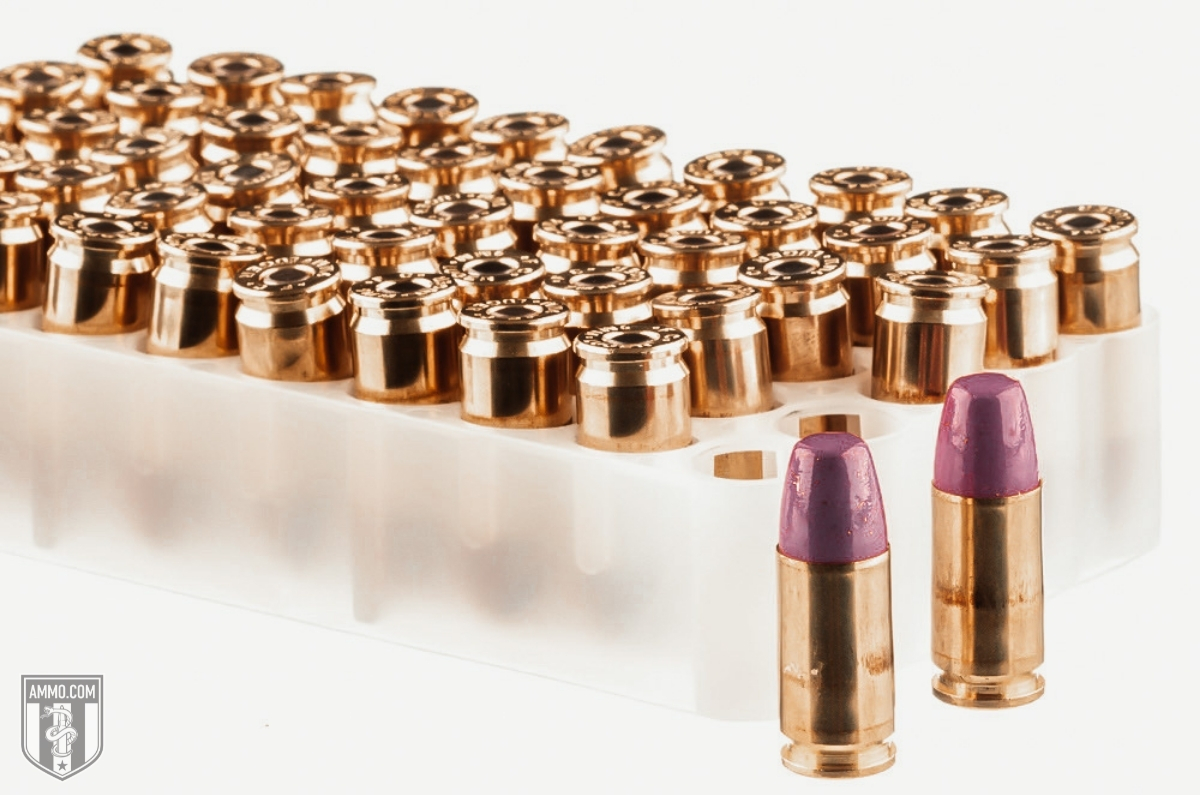
As Newton taught us in high school, “For every action, there is an equal and opposite reaction.” (And you said you’d never use physics in the real world!)
This means that the heavier powder charge and heavier bullet in the 45 ACP is going to push back on the shooter harder than a 9mm.
There is one caveat to this though, and that is firearm choice.
A classic, steel-framed 1911 is going to be considerably heavier than a polymer-framed Glock 21, M&P45, or Ruger SR-45. That added frame weight is going to reduce the amount of felt recoil that is imparted into the shooter’s hands.
This is the main reason why 1911 owners will often state that the 45 ACP doesn’t have much kick to it.
However, in general, 9mm handguns will have less recoil and allow for faster follow-up shots as shooters can get their sights back on target quicker.
Less recoil also tends to lead to improved accuracy and shot placement. And as I’m sure you’re well aware, shot placement is the key to stopping a threat.
Many shooters will find that they are more accurate shooting a 9mm and this is often due to less recoil. The gentler shooting 9mm allows shooters to focus on the fundamentals of shooting (trigger control, sight alignment, grip, stance) and develop good habits over bad ones like recoil anticipation.
The FBI also agrees with this as they began phasing out their 40 S&W service pistols and moving back to the 9mm round in 2015. Their findings suggested that less recoil allowed their agents to reduce their split times (time between shots) which allowed them to end engagements quicker with better shot placement.
Lower felt recoil is an advantage for the 9mm Luger as it makes the firearm easier to handle, allowing for better shooting fundamentals and follow-up shots.
45 ACP vs 9mm: Velocity and Accuracy
It’s incredibly difficult to compare the accuracy of two handgun calibers as it is largely dependent upon the shooter and the firearm used.
Both the 9mm and the 45 ACP have won the Service Pistol competition at the National Matches at Camp Perry. All things being equal, there is no difference in accuracy between the 9mm and 45 ACP.
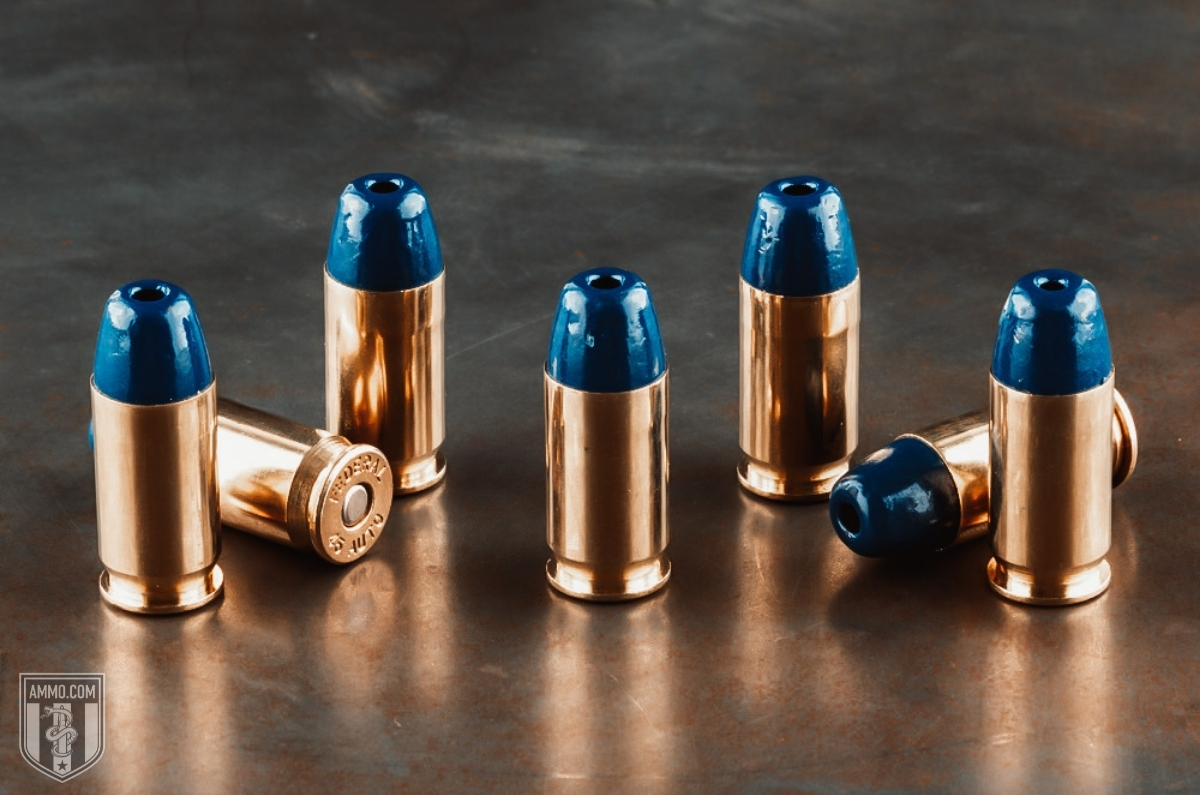
However, there is one caveat and that would be muzzle velocity. As the 9mm round fires a lighter bullet at a higher velocity, it will have less bullet drop over distance making it the better choice for long range shots.
Unless you practice like Jerry Miculek, it’s unlikely you’ll be taking shots with your 9mm over 25 yards. However, should the moment arise when a long-range shot is required, you’ll have to compensate less for bullet drop with the 9mm.
Although the 45 ACP will not be the best choice for long-range engagements, its lower muzzle velocity makes it is an ideal candidate for suppressed fire. Being naturally subsonic and having lower chamber pressure, the 45 ACP is easier to suppress than a 9mm.
There are subsonic (under 1000 fps) options for the 9mm with 147+ grain loadings that play nice with a silencer, but the 45 ACP is simply a joy to fire suppressed and most shooters prefer it in this role.
45 vs 9mm: Home Defense and Concealed Carry
With advancements in hollow point technology, the gap between the stopping power between the 45 ACP and 9mm has been closed to an extent.
However, the fact that the 45 ACP has lower penetration makes it an ideal choice for home defense. This means it is less likely that the bullet will penetrate through the bad guy, your internal/external walls, and into Little Johnny playing COD next door.
Always know what your backstop is and what lies behind your target, as you are liable for every bullet you fire, even in a self-defense situation. However, in an urban setting, lower penetration while still penetrating deep enough to cause critical damage to internal organs is ideal…and this is what the 45 ACP offers.
The added weight of 45 ACP firearms makes little difference when it’s stowed safely in your bedside gun vault. Furthermore, a heavier semi-auto pistol like a 1911 will soak up more of that 45 ACP recoil (and is also a viable club should you run out of ammo).
This is not to say that a 9mm is insufficient for home defense, it most certainly will get the job done. You just run the potential for over penetration which is a possible liability issue. However, modern hollow points or frangible ammo minimize this risk and you should not feel insecure using a 9mm for home defense.
Concealed carry is another issue entirely as there are more factors to consider when you are putting together your EDC.
Handgun weight and width play a big role in comfort when you are going to concealed carry any firearm. And there’s no denying that a 45 ACP handgun will be thicker and heavier than its 9mm equivalent.
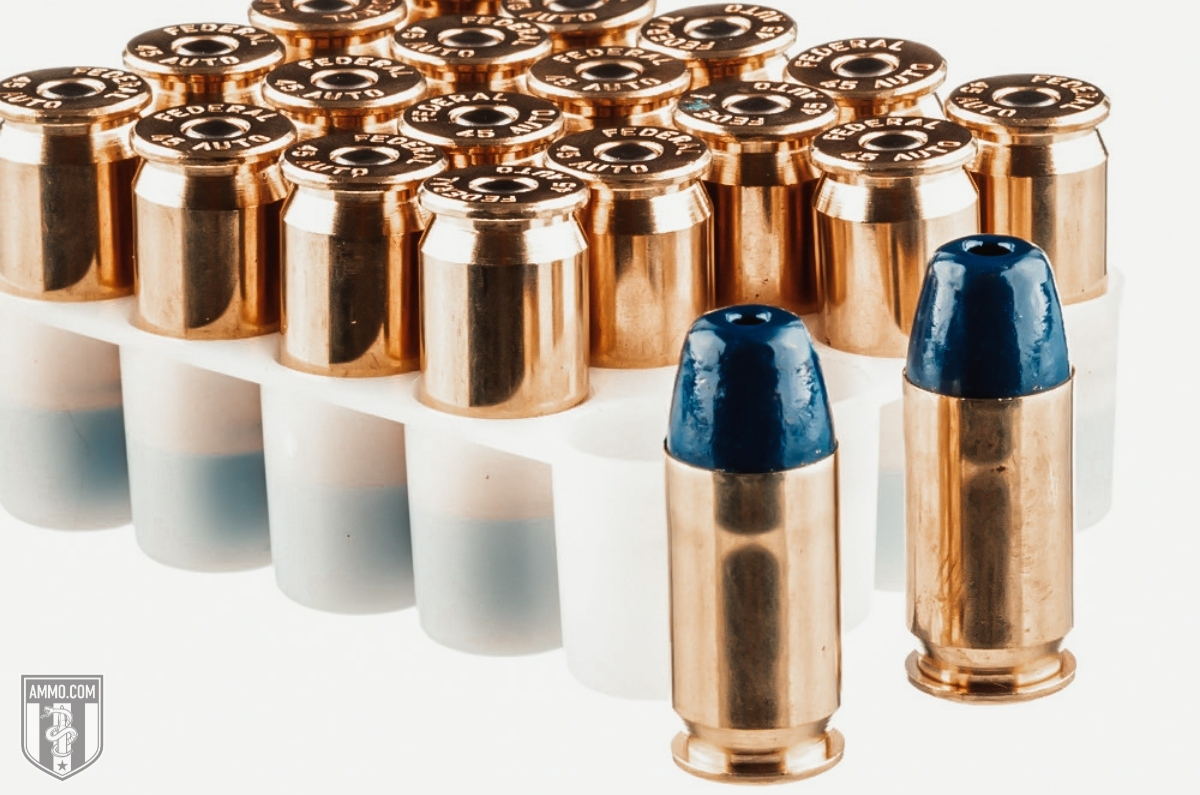
There are many concealed carry permit holders who EDC a 45 ACP every day, and if they are willing to take on the added weight then I say more power to you.
However, for your average CCW permit holder, that 45 ACP is going to wear on them day in and day out. Thoughts will start creeping into their minds, “I’m just going to Wal-Mart…No need to tote the 1911 today, it’s constantly digging into my thigh…Everything will be fine if I just leave it at home!”
And soon enough, that 1911 they swore they’d carry every day has been relegated to nightstand duty.
The simple truth is a 9mm pistol is going to be easier to carry as it is lighter, thinner, and you can carry more ammo for it.
45 ACP vs 9mm: Handgun Availability and Price
The 9mm and 45 ACP are the two most popular pistol calibers in the world. Every major firearms manufacturer who sells handguns has at least one semi-auto pistol dedicated to 9mm Luger and 45 ACP.
The sky is the limit in terms of firearms design, size, grip angle, and construction material. This allows you to purchase a handgun that fits you like a glove.
One upside for 9mm handguns is that they are typically cheaper than a 45 ACP offering of similar size. This is due to fewer materials being required for a 9mm as a 45 requires heavier construction to handle the increased recoil.
Other than this one caveat, you should have zero issues finding a handgun in either caliber.
45 ACP vs 9mm: Ammo Availability and Price
Ammo for both 9mm and 45 ACP is plentiful and easy to find. There are various offerings from FMJ, numerous jacketed hollow point (JHP) configurations, and even +p loadings.
However, 9mm ammo is going to be about half the price of 45 as it fires a smaller bullet and requires less powder and brass for construction.
This means you can practice with your 9mm more with less of a hit to the wallet.
Buying in bulk is always smart, make sure to check out our stock of bulk 9mm ammo and 45 acp bulk ammo.
45 ACP vs 9mm: Reloading

If you were to ask me what pistol cartridge a new reloader should learn on, the 45 ACP and 9mm are the two I would recommend.
These two pistol calibers are the simplest to reload that I’ve ever seen and there are a multitude of components for you to choose from to develop your ideal load.
Do note that some 45 ACP brass casings are now using small pistol primers as opposed to large pistol primers. This means you will need to segregate your brass to not mix these two up during reloading.
OR! Simply throw away the heretical small pistol primer 45 ACP brass because John Moses Browning designed the 45 for a large pistol primer and anything less is an afront to nature.
45 ACP vs 9mm Ballistics
Our team here at Ammo.com has put together some top-notch ballistics tables so you can compare the numbers for both the 45 ACP and 9mm in your favorite loading.
45 ACP Ballistics
Note: This information comes from the manufacturer and is for informational purposes only. The actual ballistics obtained with your firearm can vary considerably from the advertised ballistics. Also, ballistics can vary from lot to lot with the same brand and type load.
| 45 Auto (ACP) Bullet WEIGHT | Muzzle VELOCITY (fps) | Muzzle ENERGY (ft. lbs.) | Mid-Range TRAJECTORY (in.) | Barrel Length (in.) | |||||
|---|---|---|---|---|---|---|---|---|---|
| Muzzle | 50 yds. | 100 yds. | Muzzle | 50 yds. | 100 yds. | 50 yds. | 100 yds. | ||
| 150 Grain | 1050 | n/a | n/a | 403 | n/a | n/a | n/a | n/a | n/a |
| 165 Grain | 1030 | 930 | n/a | 385 | 315 | n/a | 1.2 | n/a | 5" |
| 165 Grain Guard Dog | 1140 | 1030 | 950 | 475 | 390 | 335 | n/a | n/a | 5" |
| 185 Grain | 1000 | 940 | 890 | 410 | 360 | 325 | 1.1 | 4.9 | 5" |
| 185 Grain Match | 770 | 705 | 650 | 245 | 204 | 175 | 2 | 8.7 | 5" |
| 200 Grain | 940 | 890 | 840 | 392 | 352 | 312 | 2 | 8.6 | 5" |
| 200 Grain | 975 | 917 | 860 | 421 | 372 | 328 | 1.4 | 5 | 5" |
| 230 Grain | 830 | 800 | 675 | 355 | 325 | 300 | 1.6 | 6.8 | 5" |
| 230 Grain | 880 | 846 | 816 | 396 | 366 | 340 | 1.5 | 6.1 | 5" |
| 165 Grain +P | 1250 | n/a | n/a | 573 | n/a | n/a | n/a | n/a | n/a |
| 185 Grain +P | 1140 | 1040 | 970 | 535 | 445 | 385 | 0.9 | 4 | 5" |
| 200 Grain +P | 1055 | 982 | 925 | 494 | 428 | 380 | n/a | n/a | 5" |
9mm Ballistics
Note: This information comes from the manufacturer and is for informational purposes only. The actual ballistics obtained with your firearm can vary considerably from the advertised ballistics. Also, ballistics can vary from lot to lot with the same brand and type load.
| 9mm Bullet WEIGHT | Muzzle VELOCITY (fps) | Muzzle ENERGY (ft. lbs.) | Mid-Range TRAJECTORY (in.) | Barrel Length (in.) | |||||
|---|---|---|---|---|---|---|---|---|---|
| Muzzle | 50 yds. | 100 yds. | Muzzle | 50 yds. | 100 yds. | 50 yds. | 100 yds. | ||
| 80 Grain | 1445 | n/a | n/a | n/a | 385 | n/a | n/a | n/a | n/a |
| 88 Grain | 1500 |
1190 | 1010 | 440 | 275 | 200 | 0.6 | 3.1 | 4" |
| 90 Grain | 1360 | 1112 | 978 | 370 | 247 | 191 | n/a | n/a | 4" |
| 92 Grain | 1325 | 1117 | 991 | 359 | 255 | 201 | -3.2 | n/a | 4" |
| 95 Grain | 1300 | 1140 | 1010 | 350 | 275 | 215 | 0.8 | 3.4 | 4" |
| 100 Grain | 1180 | 1080 | n/a | 305 | 255 | n/a | 0.9 | n/a | 4" |
| 105 Grain "Guard Dog" | 1230 | 1070 | 970 | 355 | 265 | 220 | n/a | n/a | 4" |
| 115 Grain | 1155 | 1045 | 970 | 340 | 280 | 240 | 0.9 | 3.9 | 4" |
| 123 Grain | 1110 | 1030 | 970 | 340 | 290 | 260 | 1 | 4 | 4" |
| 124 Grain | 1150 | 1040 | 965 | 364 | 298 | 256 | -4.5 | n/a | 4" |
| 125 Grain | 1110 | 1030 | 970 | 340 | 290 | 260 | 1 | 4 | 4" |
| 135 Grain | 1010 | 960 | 918 | 306 | 276 | 253 | n/a | n/a | 4" |
| 140 Grain | 935 | 890 | 850 | 270 | 245 | 225 | 1.3 | 5.5 | 4" |
| 147 Grain | 990 | 940 | 900 | 320 | 290 | 265 | 1.1 | 4.9 | 4" |
| 90 Grain +P | 1475 | n/a | n/a | 437 | n/a | n/a | n/a | n/a | 4" |
| 115 Grain +P | 1250 | 1113 | 1019 | 399 | 316 | 265 | 0.8 | 3.5 | 4" |
| 124 Grain +P | 1180 | 1089 | 1021 | 384 | 327 | 287 | 0.8 | 3.8 | 4" |
Conclusion: Settling the 45 ACP vs 9mm Debate
It’s unlikely that the 9mm vs 45 ACP debate will ever be settled as shooters from both camps have dug their heels into their position and won’t budge.
Both cartridges offer distinct advantages and disadvantages that the individual firearm owner will need to weigh when making their final purchase decision.
The 9mm Luger offers superior magazine capacity, low recoil, and lighter firearms allowing for easier carriage and the ability to put multiple shots on target in quick succession.
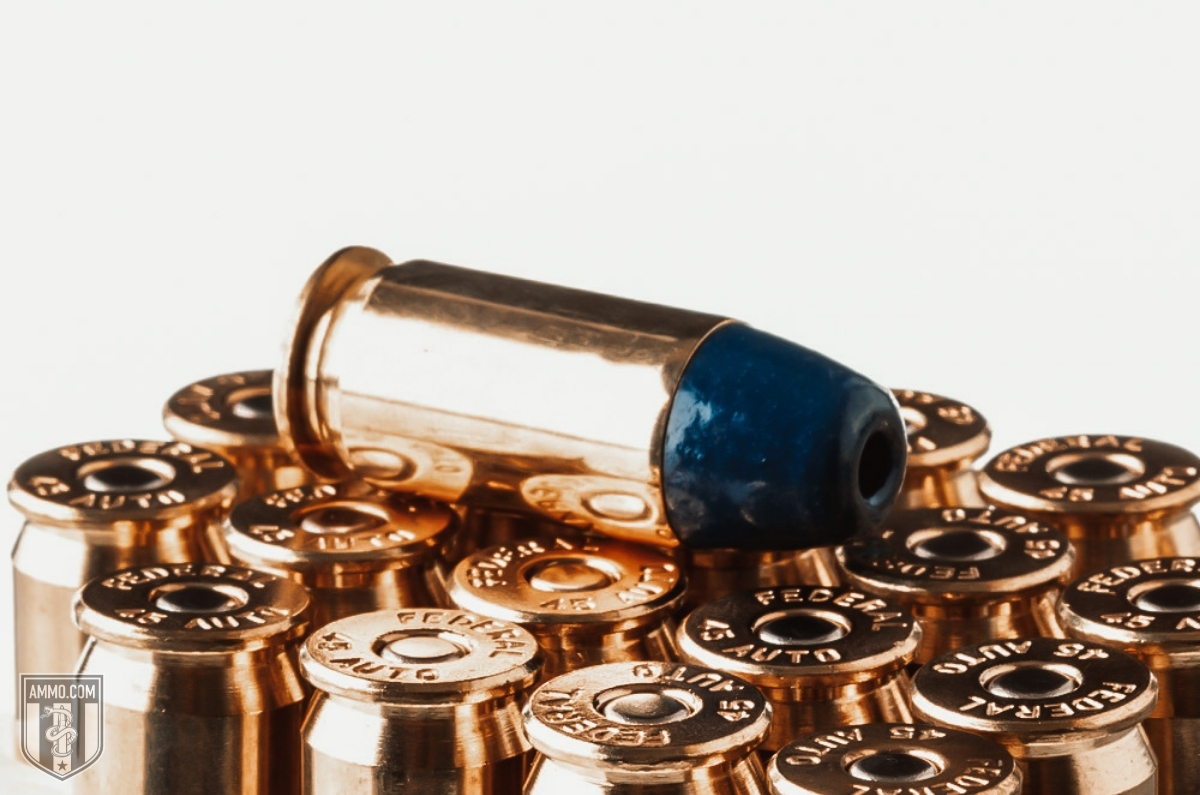
However, the 9mm bullet is lighter and leaves a smaller permanent wound channel, although advancements in hollow point technology have helped resolve this issue to a point.
The 45 ACP is a battle-tested round that won two World Wars and offers superior stopping power at the cost of reduced magazine capacity and added overall weight.
Which round works best for YOU depends on your personal preferences and what role you want your new handgun purchase to fill.
For EDC, 9mm is the preferred choice for many CCW permit holders. However, if you feel more comfortable carrying a 45 ACP then lock and load and carry it. Just understand that you’ll need to invest in a quality belt and holster to offset the added weight of a 45 ACP handgun.
For home defense, a 45 ACP is the better choice as reduced penetration makes it a safer option for use in an urban setting. However, you should not feel outgunned if you must defend your home with a 9mm.
No matter which pistol caliber you choose, you can rest assured that in the moment when you need your handgun to perform, the 45 ACP and 9mm will not let you down. Quality hollow point ammo will stop any assailant so long as your shot placement is sufficient.
Therefore, you need to grab some FMJ ammo and hit the range to practice with your chosen caliber, so YOU are ready when the 9mm vs 45 ACP debate is a distant memory in the back of your mind. Shot placement trumps caliber selection every time, so be proficient with your EDC handgun and carry what you shoot best. Stay safe out there my CCW brothers and sisters.
Ammo Comparisons
- .308 vs 5.56
- 6.5 Creedmoor vs .308
- .300 Blackout vs .308
- .300 Win Mag vs .308
- .243 vs .308
- .308 vs .30-06
- 7mm-08 vs .308
- .270 vs .308
- 7.62x39 vs .308
- .223 vs .308
- .338 Lapua vs .308
- .380 ACP vs 9mm
- .223 vs 5.56
- .300 Blackout vs 5.56
- 9mm vs 45 ACP
- 9mm vs 40 S&W
- .357 SIG vs 9mm
- 10mm vs 9mm
- 9mm vs 9mm Luger
- .243 vs .270
- .300 Win Mag vs .30-06
- .270 vs .30-06
- .40 vs .45
- 38 Special vs 357
- 9mm vs 40 vs 45
- 5.56 vs 7.62x39
- 338 Lapua vs .30-06
- .30-30 vs .30-06
- 300 PRC vs 338 Lapua
- .30-06 vs 7mm
- 300 Win Mag vs 338 Lapua
- 300 PRC vs 300 Win Mag
- 300 WSM vs 300 Win Mag
- 338 Win Mag vs 338 Lapua
- 12 Gauge vs 20 Gauge
- 10mm vs 357 Mag
- .30-30 vs 7.62x39
- 224 Valkyrie vs 22-250
- 17 HMR vs 22 Mag
- 7.62x39 vs .300 Blackout
- 45 ACP vs 45 Auto
- 45-70 vs 30-30
- 300 Blackout vs 223
- 357 Magnum vs 9mm
- 350 Legend vs 300 Blackout
- 224 Valkyrie vs 223
- 45 ACP vs 38 Super
- 6.5 Grendel vs .308
- 17 HMR vs 22 LR
- 10 Gauge vs 12 Gauge
- 22-250 vs 223
- 45 Colt vs 45 ACP
- 350 Legend vs 30-30
- 5.7x28 vs 223
- 5.7 vs 9mm
- 5.56 vs 5.7
- 22 vs 9mm
- Buckshot vs Birdshot
- 450 Bushmaster vs 308
- 450 Bushmaster vs 223
- Buckshot vs Slug
- 6.5 Grendel vs 5.56 vs 223
- 6mm ARC vs 6.5 Grendel
- 44 vs 45
- 458 SOCOM vs 5.56
- 357 vs 44
- 32 ACP vs 380
- 300 Win Mag vs 338 Win Mag vs 338 Lapua Mag
- 450 Bushmaster vs 458 SOCOM vs 50 Beowulf
- 6mm Creedmoor vs 6.5 Creedmoor
- TMJ vs FMJ
- 44 Special Vs 44 Magnum
- 45 90 vs 45 70
- 6.8 Western vs 6.8 SPC
- 50 Beowulf vs 50 BMG
- 26 Nosler vs 6.5 PRC
- 28 Gauge vs 410
- 6.8 SPC vs 5.56
- 6.8 SPC vs 6.5 Grendel
- 6.8 Western vs 7mm Rem Mag vs .28 Nosler
- 6.8 Western vs 6.5 Creedmoor
- 22 Hornet vs 223
- 6.8 Western vs 6.5 PRC
- .410 vs 12 Gauge
- .410 vs 20 Gauge
- 22 LR vs 22 Mag
- 6mm ARC vs 243
- 7mm-08 vs 270
- 243 vs 6.5 Creedmoor
- Nickel vs Brass Casing
- 204 Ruger vs 223
- 50 Beowulf vs 5.56
- 260 Remington vs 6.5 Creedmoor
- 6mm Remington vs 243
- 28 Nosler vs 300 PRC
- 50 Beowulf vs 50 AE
- 22 Nosler vs 22-250
- 450 Marlin vs 45-70
- 300 Win Mag vs 300 Norma
- 458 SOCOM vs 300 Blackout
- 38-55 vs 45-70
- 22 Hornet vs 22 LR
- 300 Norma vs 338 Lapua
- 338 Lapua vs 50 BMG
- 28 Nosler vs 300 Win Mag
- 28 Nosler vs 6.5 Creedmoor
- 204 vs 22-250
- 458 SOCOM vs 45 70
- 44 40 vs 45 70
- 6.8 SPC vs 6.5 Creedmoor
- 450 Bushmaster vs 30-06
- 7mm Rem Mag vs 300 Win Mag
- 30 Carbine vs 223
- 25-06 vs 30-06
- 26 Nosler vs 28 Nosler
- 16ga vs 12ga
- 30 06 vs 7.62 x54R
- 9mm Makarov vs 9mm Luger
- 350 Legend vs 223
- 30 Carbine vs 5.56
- 6.5x55 vs 6.5 Creedmoor
- 6.5 Creedmoor vs 270 vs 25-06
- M193 vs M855
- 450 Bushmaster vs 458 SOCOM
- 6.5 Grendel vs 6.5 Creedmoor
- 350 Legend vs 5.56
- .277 Fury vs 6.8 SPC
- 277 Fury vs 300 Win Mag
- 10mm vs .45 ACP
- 277 Fury vs 223
- 6.8 SPC vs 300 Blackout
- 6.5 PRC vs 6.5 Creedmoor
- 277 Fury vs 308
- 277 Fury vs 6.5 Creedmoor
- 350 Legend vs 450 Bushmaster
- 277 Fury Vs 5.56 NATO
- 10mm vs 40S&W
- 32 ACP vs 9mm
- 32 Special vs 9mm
- 8.6 Blackout vs 300 Blackout
- 30 Super Carry vs. 9mm
- 5.56 vs 9mm
- .50 Action Express vs 9mm
- 7.62x25 vs. 9mm
- 10mm vs 44 Magnum
- 300 Blackout vs 300 Win Mag
- 6.5 Grendel vs 300 Blackout
- 460 Rowland vs 10mm
- 300 RUM vs 300 PRC
- 300 Norma vs 300 PRC
- 45 GAP vs 45 ACP
- 7mm PRC vs 300 Win Mag
- 300 PRC vs 6.5 Creedmoor
- 300 PRC vs 308
- 357 SIG vs 357 Mag
- 7.62x39 vs 7.62x51
- 243 Win vs 223 Rem
- 30 Nosler vs 300 PRC
- 6.5 Creedmoor vs. 30-06 Springfield
- 450 S&W vs. 44 Magnum
- 6.5 Creedmoor vs. 300 Win Mag
- 454 Cassull vs. 45-70 Govt
- 454 Cassull vs. 44 Mag
- 7.62x54r vs. 308 Winchester
- 22 ARC vs. 223 Rem
- Subsonic vs. Supersonic Ammo
